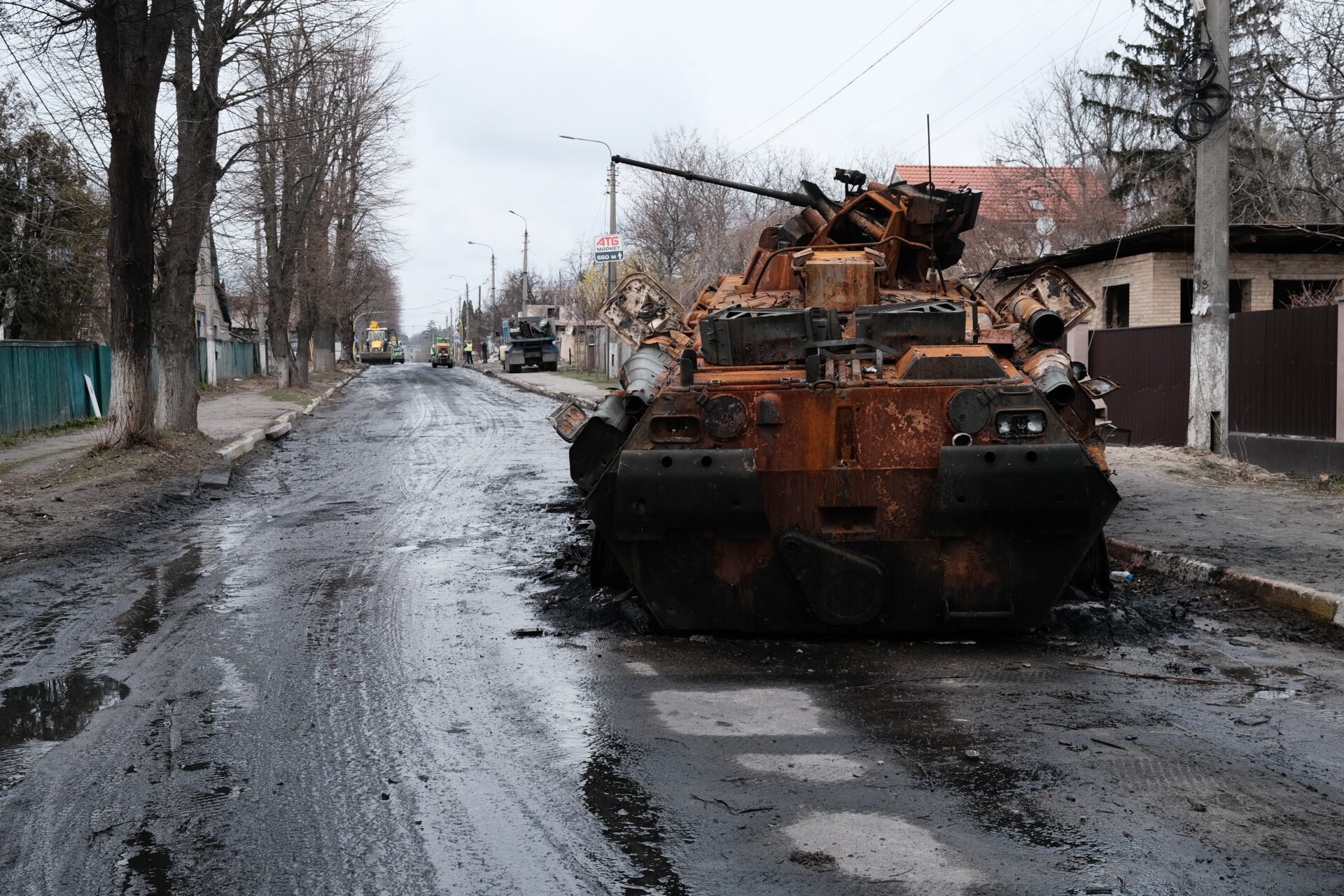“Adults in a Room” is a series in collaboration with The Stimson Center’s Reimagining US Grand Strategy program. The series stems from the group’s monthly networking events that call on analysts to gather virtually and hash out a salient topic. It aims to give you a peek into their Zoom room and a deep understanding of the issue at hand in less than the time it takes to sip your morning coffee without the jargon, acronyms, and stuffiness that often come with expertise.
Russia’s invasion of Ukraine in 2022 shocked the world, partly because many assumed the type of warfare Russia had decided to undertake was confined to a past era. There were assumptions abound about how the war would go, many of which were quickly proven wrong. A year in, the war in Ukraine has provided many lessons about modern warfare and continues to raise concerns about what might come next.
The Reimagining US Grand Strategy program’s February 2023 roundtable brought experts together to discuss what they had learned from the war in Ukraine so far. Two specific issues came up repeatedly: the persisting threat of escalation to nuclear conflict and the importance of logistics in war. Participants also discussed what Russia’s role in the world might be going forward and whether attempts to isolate Russia have been as successful as theorized at the start of the invasion. Several discussed the role of the private sector in aiding Ukraine.
Four experts share their main takeaways from the first year of Russia’s war in Ukraine below.
Christopher Preble, Senior Fellow and Director, Stimson Center’s Reimagining US Grand Strategy Program
One recurring theme throughout the conflict has been a tendency to downplay the nuclear risks. This is especially prevalent among those wishing to do more to help Ukraine and punish Russia. For example, when President Joe Biden observed that “the prospect of Armageddon” was at the highest point since the Cuban Missile Crisis in 1962, Kori Schake scolded that such “public expressions of anxiety” served to “reward Russia for making nuclear threats.” Others have advised against being “intimidated or self-deterred by Russian saber-rattling.” Underlying such warnings is a fear that any appearance of Russian “success” would convince others to engage in similar acts of naked aggression without fear of retaliation.
Nuclear weapons loom over the war in Ukraine and will continue to do so. That the conflict has not (yet) crossed the nuclear threshold should not be taken as definitive proof that Putin’s threats are not credible.
But what has transpired over the last year doesn’t look like “success.” Indeed, it is hard to imagine any leader of any country wanting to emulate President Vladimir Putin. The Russian military has been decimated, its economy has been battered (though not as badly as some had hoped), Europe is weaning itself off Russian energy, NATO is poised to add two new members, and Russia’s international standing has plummeted. The Ukraine war is merely the latest reminder that aggression doesn’t pay. People will fight to preserve their independence, even when facing a much larger and more militarily powerful foe.
Facing the prospect of a conventional military defeat, Putin has brandished the nuclear card, but without much success. The United States and NATO have been deterred from intervening directly in the war, but Putin’s nuclear threats failed to compel Ukraine to capitulate before the war started — and seem no more effective one year in. And this confirms what we already knew about nuclear weapons: they are better for deterrence than for coercion.
Much as we might like it to be otherwise, nuclear weapons do loom over the war in Ukraine — and they will continue to do so, as long as the fighting continues. That the conflict has not (yet) crossed the nuclear threshold should not be taken as definitive proof that Putin’s threats are not credible. As Kelly Grieco and I note, “The most dangerous lesson Washington could possibly take away from the last year of the war is that it should fear nuclear weapons less. Indeed, the nuclear dangers remain and continue to rise, particularly if Putin grows more desperate.”
Finding a way to stop Russia’s horrible war would end the suffering of the Ukrainian people and allow them to start the long process of rebuilding. An end to the fighting would also substantially reduce the risk of nuclear use, which thankfully remains a low-probability event, but one that has enormous consequences.
Erica D. Lonergan, Assistant Professor, Army Cyber Institute at West Point*
A core US policy objective in Ukraine is preventing the escalation of the conflict, especially the use of nuclear weapons. Given Russia’s nuclear arsenal and Putin’s penchant for nuclear threats, this goal is wise and entirely unobjectionable. However, how some policymakers and experts talk about escalation in Ukraine — focusing on nuclear escalation pathways — risks missing the important ways the conflict has already escalated and may continue to do so in the future.
Indeed, the Ukraine war is forcing policymakers to “think about the unthinkable.” Fears of nuclear escalation prompted the Bulletin of Atomic Scientists to set the Doomsday Clock at 90 seconds to midnight this January. And at a recent CNN town hall with Administrator of the US Agency for International Development Samantha Power and National Security Advisor Jake Sullivan, marking the one-year anniversary of Russia’s invasion, the discussion of potential escalation focused on nuclear scenarios.
Policymakers focus on nuclear escalation pathways risks missing the important ways the conflict has already escalated and may continue to do so in the future.
Yet, a binary perspective on the concept of nuclear escalation (focusing on the use or non-use of nuclear weapons) obscures how escalation scholars have actually theorized about the varied nature and forms of escalation. Escalation is not just a one-way vertical ratchet up Herman Kahn’s 44-rung escalation ladder to nuclear Armageddon. It could also occur horizontally, expanding the scope of a conflict or through non-linear pathways or, most worrisome, through inadvertent mechanisms. And, even in Kahn’s famed depiction, “barely nuclear war” is only rung 15 of the escalation ladder, with many more rungs to go — both conventional and nuclear — until the nuclear “spasm” at the highest rung.
Concentrating on nuclear escalation in Ukraine also overlooks the ways in which the conflict has already escalated — and may yet escalate further — even if nuclear weapons are never used. For instance, on the Russian side, Putin’s announcement of a “partial mobilization” in September 2022 represented an escalation of its involvement in the conflict. An announcement of a move to full Russian mobilization (which has not yet occurred) would signify another level of Russian escalation.
A prospective decision by China to provide lethal support to Russia would represent another form of escalation. On the US side, Biden’s January 2023 announcement that the United States would deliver Abrams tanks to Ukraine (followed by Germany’s approval of Leopard tanks to Ukraine) escalated Western involvement in the conflict by introducing a significant new capability to the battlefield.
Indeed, the overall US strategy toward Ukraine has been defined by an incremental, calibrated escalation of involvement ostensibly designed to avoid decisively crossing any Russian red lines in a way that would prompt unacceptable retaliation. Yet, this approach risks numbing both US policymakers and the American people to the real ways in which escalation has already occurred and may distort calculations about the likelihood of further escalation. In applying the boiling frog approach to Russia, policymakers are missing how the United States is in the same pot of water.
*The views expressed are personal and do not reflect the policy or position of any U.S. government organization or entity.
Cynthia Cook, Senior Fellow and Director, Defense-Industrial Initiatives Group, CSIS
Russian assumptions that they would quickly overrun the capital and be welcomed as liberators perhaps contributed to their lack of investment in logistics considerations, which has been evident from the earliest days of the war when broken vehicles without parts or fuel were left by the side of the road. Images of Ukrainian farmers driving tractors that were towing broken-down Russian tanks that had run out of fuel were all over the news at the beginning of the war. By contrast, Ukraine’s tilt to the West after Russia overran Crimea in 2014 included an effort to increase the professionalism of Ukrainian forces, which includes logistics thinking.
As Russia’s war in Ukraine changes shape, logistics requirements will as well, and Ukraine’s allies can usefully provide support not just with weapons, but with the logistics tail to sustain and maintain them.
There aren’t really new lessons about the importance of logistics during this war. After all, that is old news, and Russia’s war in Ukraine has proven the point many times over. “Amateurs talk strategy, and experts talk logistics” has been attributed to military leaders for centuries, and the wisdom of focusing on logistics has been proven true again. The United States has substantial existing investments in maintenance and support and considers contested logistics in its planning. What this war does prove is the importance of access to the front.
Ukraine’s geographic proximity to NATO allies meant that reinforcement could be delivered over land directly into Ukrainian-controlled territory. If the United States expects to fight in the Pacific, it will not have a land bridge for resupply. Pre-positioning equipment and supplies is one strategy to sustain the force.
Supply challenges are specifically related to consumables as the United States and its allies continue to send munitions of various sorts to Ukraine. Russia’s war in Ukraine has become a long war of attrition, and there are real concerns about munitions stocks. There are logistics considerations as well. As allies move to supply heavy vehicles, including tanks, issues of operational energy will come to the fore. Transporting the necessary fuel will take tankers and additional security forces, thus adding substantially to the necessary logistics tail. As Russia’s war in Ukraine changes shape, logistics requirements will as well, and Ukraine’s allies can usefully provide support not just with weapons, but with the logistics tail to sustain and maintain them.
Stephen Shapiro, Senior Advisor, Atlantic Council’s Scowcroft Center for Strategy and Security
At the start of Russia’s war against Ukraine, the private sector appeared to have an initial, favorable response to Russia’s aggression. By early March of 2022, some 290 companies had voluntarily ceased operations in Russia. Others stepped up essentially on a pro bono basis to assist Ukraine with various technological needs (i.e., Microsoft, Cisco, and SpaceX). However, that seemingly positive private sector response doesn’t withstand scrutiny. Many major companies — like McDonald’s, Starbucks, and Coca-Cola — didn’t leave the Russian market until only after Yale Professor Jeffrey Sonnefeld published a study tracking those companies that left and highlighting those that continued to do business in Russia.
The US private sector’s response to the Russian war has proven slow at best and unreliable at worst.
For many corporations, the commitment to exit Russia appears to be more talk than action. Sonnefeld and his Yale team separated out the “fraudsters” from the companies that truly did cease business in Russia and found there was a difference between words and deeds. According to Sonnefeld, only public shaming by the Yale list prompted over 1,000 companies to pull out. Today’s list — where companies are graded A for pulling out completely and F for continuing to do business as usual with gradations in between — shows that just about half of US companies that were in Russia before the war started are still there doing some level of business in Russia (and this number may be even higher depending on what is truly going on with those graded B).
Sonnefeld also finds that critical economic sectors — specifically oil and defense production — resisted (and some continue to resist) the president’s pleas for “urgent action” to step up production as prices soared to the detriment of US consumers and the benefit of the Russian economy. Even the commitment of a notable tech company, Starlink, faltered at a critical moment in the war when service to 1,300 units in Ukraine was interrupted seemingly over an Elon Musk demand for payment from the Pentagon, which almost literally called the company unreliable.
What might be regarded as most telling was the oil sector’s reluctant response to Biden’s calls — pleas, really — to step up drilling and production in order to lower domestic gas prices and weaken Russia’s ability to fund its war. The sector’s resistance, and wariness, was specifically for market reasons, where price fluctuations would leave it in a position of oversupply at the end of the war. A CBS News analysis done at approximately the same time as Biden was publicly pleading with the oil giants to respond had this headline: “US producers reluctant to drill more oil, despite sky-high gas prices” and quoted a senior economist:
“Investors in energy stocks have been a bit thrown off by the volatility, so they’re looking more for energy firms to pay back down their debt, or return money to shareholders, rather than going and investing in new wells — even if those new wells would be profitable.”
The same rationale is offered by defense production companies, who have not ramped up to anything close to (proxy) war-time footing. Many cite “the need for more certainty that orders will follow if companies invest more to boost capacity.” It is true that defense manufacturers also cite supply chain shortages and the sluggish procurement process as reasons for the slow response. Along with the massive erosion of the traditional defense industrial base, these concerns must be addressed to modernize and satisfy not only the United States’ current armament needs considering its supply of Ukraine from existing stocks but also to prepare for future conflict and thus to serve as a visible deterrent.
An obvious solution is to make robust use of the powers afforded the government in the Defense Production Act, which has been used in the past but sparingly during the war in Ukraine. For example, during the COVID-19 crisis, the law was used over 100 times to assist the vaccine production process and personal protection equipment manufacturing. The Defense Production Act can shorten contracting periods, prioritize supply contracts for first-line defense manufacturers (such as with Raytheon and Lockheed Martin’s production of Stingers, Javelins, and HIMARS resupply) and even direct those manufacturers to accept guarantees of purchase of future production. In other words, the law’s policy language is extremely broad and includes supporting “essential national defense needs that can result from emergency conditions.”
In short, the US private sector’s response to the Russian war — whether by cutting ties with Russia, stepping up needed domestic production in critical sectors like oil and weapons manufacture or even voluntarily aiding Ukraine on the ground — has proven slow at best and unreliable at worst. Powers afforded the US federal government by the Defense Production Act, and the Declaration of National Emergency (which has only been used to seize Russian vessels) are not being utilized, and they should be to ensure that the private sector delivers at this critical national security moment.





















